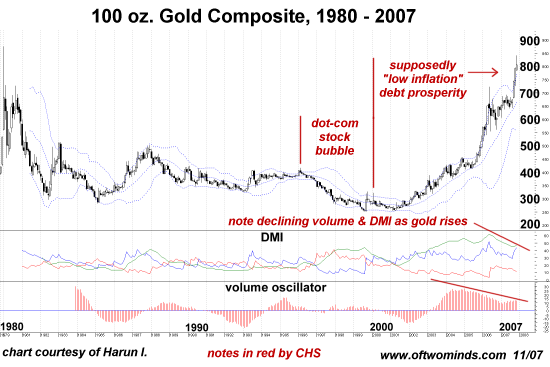

|
| weblog/wEssays archives | home | |
|
Changing Tides IV: Private Gold Currency (November 15, 2007) It's not exactly news that gold has been on a tear since 2000. Frequent contributor Harun I. was kind enough to pass along this chart of gold for the period 1980 - 2007: 
At first glance, this sure looks like gold has been rising in reaction to a highly inflationary economy. Why else would a "safe haven" of value shoot up from under $300 to over $800 in a few short years? This chart screams: somebody's lying or hallucinating. Either the U.S. Government is lying about the true rate of inflation, or gold buyers entered a 7-year state of hallucination. Which do you think is true? Gosh, that's a hard one. Of course the government is lying. And yet there are certain technical features of this chart which suggest caution to those proclaiming $1,000/oz. gold, $2,200/oz. or $3,000/oz. gold. Maybe gold will shoot up to $3,000/oz.; this chart certainly depicts an unambiguous uptrend in gold. Having noted that, let's also notice the divergences in DMI and volume, both of which are declining even as gold ran up in its recent parabolic rise. Could gold be setting up for a breather, or a serious retrace? Just as an opinion, not a prediction, I would say, hmm, why not? Nothing goes up in a straight line without occasional retraces. But what if another trend is gathering force beneath the surface of gold's rise? That force is probably known to the majority of you, and it's called the devaluation of all "fiat" or paper currencies. What gold's rise might be telling us is the world's residents no longer trust any paper money as a reserve of purchasing power value. Most of you also know that Republican Presidential candidate Ron Paul of Texas has proposed the radical idea (at least radical to the mainstream media) that the U.S. return to the gold standard, i.e. a currency backed not by promises but by gold. Most mainstream media sources dismiss this as a "lunatic fringe" notion. Yet not too long ago, the "lunatic fringe" idea was fiat money could be used to trade across borders for real goods. Here is an extremely important essay from the pages of Foreign Affairs Magazine, (one of my regular reads), entitled The End of National Currency (May/June 2007, by Benn Steil, Director of International Economics at the Council on Foreign Relations and a co-author of Financial Statecraft.) The author covers gold, international trade and fiat money succinctly, and then addresses a truly radical idea: a revival of gold money through private gold banks. In other words: Forget government "fiat" currency, whether it's dollar, yuan, euro or yen--beneath the surface of the usual forex ups and downs, they're all trending down together. Forget trying to save essentially worthless paper money--store your wealth and transact your international business in private gold banks. How would this work? The gold ETFs offer one pathway. Gold-backed exchange-traded funds (ETFs) have been accumulating physical piles of gold--hundreds of tons of the yellow metal. That is their promise: when you buy a share of a gold ETF, you're buying a sliver of actual gold, not a mining company or financial instrument like an option or derivative. It doesn't take too much imagination to foresee an ETF accumulating, say, 500 tons of gold-- more or less the reserves of a small nation. Then the ETF launches the electronic equivalent of a currency--let's call them quatloos. (Hat tip to fellow Star Trek fans.) So if I want to transaction some business internationally, in a currency with an assured value, I would deposit whatever fiat currency I had in hand into the ETF and then wire the gold-backed quatloos to my trading partner wherever the firm might be located geographically. As all the globe's fiat currencies lose value, my quatloos would retain their purchasing power value everywhere in the world. Of course governments may well decide to confiscate their citizen's gold--as the U.S. government did in the mid-1930s--but if the bank is in Switzerland (for instance) and the transactions are all electronic transfers of quatloos, what exactly is there for our dear government to confiscate? Of course I would use dollars in the U.S. and yuan in China for my daily living expenses, but my big holdings and business transactions would be made in quatloos, electronically. Here are some excerpts from Mr. Steil's essay: Capital flows were enormous, even by contemporary standards, during the last great period of "globalization," from the late nineteenth century to the outbreak of World War I. Currency crises occurred during this period, but they were generally shallow and short-lived. That is because money was then -- as it has been throughout most of the world and most of human history -- gold, or at least a credible claim on gold.I recommend the entire essay; it is free online at the link above. Thank you, S. B., ($40), for your generous contribution to this humble site. I am greatly honored by your readership and support. All contributors are listed below in acknowledgement of my gratitude. For more on this subject and a wide array of other topics, please visit my weblog. copyright © 2007 Charles Hugh Smith. All rights reserved in all media. I would be honored if you linked this wEssay to your site, or printed a copy for your own use. |
||
| weblog/wEssays | home |